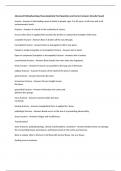Advanced Pathophysiology Musculoskeletal Test Questions and Correct Answers Already Passed
trauma - Answers Is the leading cause of death of people, ages 1 to 44 years, of all races and at all
socioeconomic levels.
fracture - Answers Is a break in the continuity of a bone.
Occurs when force is applied that exceeds the tensile or compressive strength of the bone.
complete fracture - Answers Bone is broken all the way through.
incomplete fracture - Answers Bone is damaged but still in one piece.
Closed or simple (complete or incomplete) fracture - Answers skin is intact
Open or compound (complete or incomplete) fracture - Answers skin is broken
comminuted fracture - Answers Bone breaks into more than two fragments.
linear fracture - Answers Fracture runs parallel to the long axis of the bone.
oblique fracture - Answers Fracture of the shaft of the bone is slanted.
spiral fracture - Answers Encircles the bone.
transverse fracture - Answers Occurs straight across
the bone.
greenstick fracture - Answers Perforates one cortex and
splinters the spongy
torus fracture - Answers Cortex buckles but does
not break.
bowing fracture - Answers Longitudinal force is applied to a bone.
pathologic fracture - Answers Break occurs at the site of a preexisting abnormality.
stress fracture - Answers Fatigue and insufficiency
Transchondral
bone fractures, pathophysiology, clinical manifestations, treatment - Answers Broken bone can damage
the surrounding tissue, periosteum, and blood vessels in the cortex and marrow.
Bone is unique: After a fracture it will heal with normal tissue, not scar tissue.
Healing occurs in phases.
,Clinical manifestations
Unnatural alignment, swelling, muscle spasm, tenderness, pain, impaired sensation
Treatment
Closed manipulation, traction (skeletal or skin), open reduction, internal fixation, external fixation
Splints and casts
bone injury-modeling process - Answers Inflammatory Phase
Lasts 3 to 4 days
Bone tissue destruction triggers an inflammatory response
Hematoma formation
Repair Phase
Lasts several days
Capillary ingrowth, mononuclear cells, and fibroblasts transforms hematoma into granulation tissue
Osteoblasts within the procallus synthesize collagen and matrix to form callus
Remodeling Phase
Lasts months to years
Unnecessary callus
is resorbed, and trabeculae are formed
At the end, bone can withstand normal stresses
improper reduction or immobilization: nonunion, delayed union, malunion - Answers Nonunion
Is the failure of the bone ends to grow together.
Gap between the broken ends of the bone fills with dense fibrous and fibrocartilaginous tissue.
Occasionally, fibrous tissue contains a fluid-filled space that resembles a joint: Referred to as a false joint
or a pseudarthrosis.
Delayed union
Does not occur until approximately 8 to 9 months after a fracture.
,Malunion
Is healing of the bone in a nonanatomic position.
Treatment: Designed to stimulate new bone formation
Implantable or external electric current devices, electromagnetic field generations, and low-density
ultrasound
Stem cell and gene therapy
Bone graft or synthetic materials (calcium phosphate cement): To fill large defects
dislocation & subluxation - Answers Dislocation
Temporary displacement of bone from its joint
Subluxation
Contact between the bones in the joint only partially lost
Associated with fractures, muscle imbalance, rheumatoid arthritis, other joint instability
Clinical manifestations
Pain, swelling, limitation of motion, joint deformity
Treatment
Reduction and immobilization for 2 to 6 weeks
Exercises
muscle strain - Answers Tear or injury to a tendon (fibrous connective tissue that attaches skeletal
muscle to bone)
Is a sudden, forced motion, causing the muscle to become stretched beyond its normal capacity.
Causes local muscle damage.
Can also involve the tendons.
Regardless of the cause of trauma, muscle cells can usually regenerate.
, May take up to 6 weeks.
sprain - Answers Tear or injury to a ligament (fibrous connective tissue that connects bones)
avulsion - Answers Complete separation of a tendon or ligament from its bony attachment site
support structure trauma: strain, sprain, avulsion. pathophysiology, clinical manifestations, treatment -
Answers Pathophysiology
Inflammatory exudate develops between the torn ends.
Granulation tissue grows inward, and then collagen formation begins 3 to 4 days after injury.
Vascular fibrous tissue fuses the new and surrounding tissues into a single mass.
Healing tendon or ligament lacks sufficient strength to withstand a strong pull for 4 to 5 weeks after the
injury.
Clinical manifestations
Is painful and usually accompanied by soft-tissue swelling and changes in tendon or ligament contour.
Treatment
Splinting, early motion, and rehabilitation
Suturing: To treat a complete rupture
If suturing is not possible: Tendon or ligament grafting
Prolonged rehabilitation exercises
tendinitis - Answers Inflammation of a tendon
tendinosis - Answers Painful degradation of collagen fibers
bursitis - Answers Inflammation of a bursa
Are sacs lined with synovial membrane and filled with synovial fluid; sacs (bursa) are located among the
tendons, muscles, and bony prominences.
Is caused by repeated trauma.
Septic bursitis: Is caused by a wound infection.
epicondylitis - Answers Is inflammation of a tendon where it attaches to a bone.




